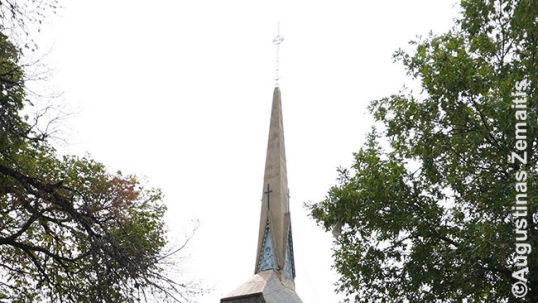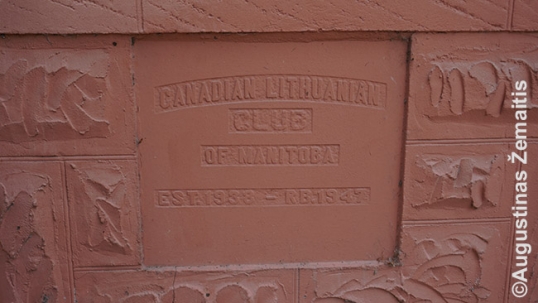Winnipeg, Manitoba
Winnipeg is home to the most outlying of Canada‘s Lithuanian enclaves. Earlier, a Lithuanian church, the Lithuanian Club, and other Lithuanian places of interest had stood there. Over time, what was once the "Lithuanian district" became a disreputable area, as other ethnic groups moved in and drug users located there. Based on some statistics, this area is the most unsafe neighborhood in the whole of Canada. As Lithuanians moved away, many of them to Canada‘s other large cities, the community became inactive and its buildings closed, though some traces of their former presence remain.
Lithuanian Church in Winnipeg
St. Casimir‘s Lithuanian Catholic Church was designed by the notable Canadian-Lithuanian architect Alfredas Kulpa-Kulpavičius. It displays an abundance of traditional decorative elements. Its spire adapts the form of a typical wayside shrine and is topped with a sunburst cross that replicates wooden folk carvings. Two similar crosses in other parts of the church have long been lost.
The number of Lithuanians in Winnipeg was never very large, peaking at 673 according to the 1961 Canadian census. For a church like this to be built by such a small community is truly amazing.

St. Casimir‘s Lithuanian Catholic Church in Winnipeg
The history of Winnipeg‘s Lithuanian church goes hand in hand with the experience of a generation that found a new life in Canada, having fled Lithuania in 1944 ahead of the approaching Soviet army of occupation. These displaced persons or "DPs," after spending four to six years in refugee camps, were allowed to emigrate. A number of them arrived in Canada around 1950 and settled in Winnipeg, where they had contracted with the Canadian government to live and work. Some of those jobs were in tuberculosis hospitals established for indigenous people. The acclaimed writer Birutė Pūkelevičiūtė did this type of work as a DP until she satisfied the terms of her contract and moved to Montreal. The immigrants, homesick for their country and eager to band together, had an ally in their plans to build a church. Rev. Justinas Bertašius, also a DP, had been ordained in 1942, in Telšiai. With his help, the church‘s foundation and basement were built in 1953; the church itself began to be constructed in 1956, and was completed and sanctified in 1959. The worship area had stained glass windows depicting Our Lady of Vilnius (Gates of Dawn) and the Hill of Three Crosses. The church hall in the basement was used for social activities, commemorations, food fairs, and a Lithuanian-language school. The parish represented Lithuania in town events.

Spire of Winnipeg‘s Lithuanian church
As long as Rev. Bertašius was alive, so was the parish. After his death in 1999, the diocese closed the church. It became a place of non-Catholic Christian worship. Other members of that generation were also dying and their children moved away or were not interested in maintaining the church, especially as the surrounding area was no longer considered safe. Hopes that the parish might continue with a Filipino priest and parishioners were not realized.
Winnipeg Lithuanian Club
St. Casimir‘s Lithuanian Catholic Church was built in the section of Winnipeg where Lithuanians lived and the Lithuanian Club already stood. Unfortunately, the church and club had their differences. The Club membership was dominated by Communists who held far-left political views. They had left Lithuania before WWI or during the interwar period and therefore had not themselves experienced Soviet repression. Some perhaps did not see Communism as a utopia, but still believed in it as a system worth trying. The viewpoint of the DPs who had to flee Soviet terror was diametrically opposed to theirs. And the idea that the Lithuanian Club had a portrait of Stalin on the wall repulsed them.
The Winnipeg Lithuanian Club was established in 1911 as a mutual aid society and was named "DLK Vytauto pašalpinė draugija" in 1912. It became "Winnipeg Lithuanian Workers Aid Society" in 1921. According to its bylaws, its members had to be righteous, not cause harm to any workers' associations or organizations, and not support anyone who might wish to betray the workers‘ ideology or harm this movement in any way.
They acquired their building in 1938 and enlarged it in 1947, demolishing the rear of the building and adding a hall and a basement.

Winnipeg Lithuanian Club
One of the many conflicts between the Communists and DPs concerned the construction of the Catholic church. Some club members tried to sabotage it, even joining the building committee in order to disrupt its work. Over time, however, a few changed their views of the Soviet Union as a paradise, turning more moderate. Some DPs became members, organizing events for the entire community. Eventually, in 1985, the Club closed and the building was sold. Some former Club members became parishioners of the Lithuanian church as this remained the only Lithuanian gathering place in the city.
Although the Winnipeg Lithuanian Club is long gone, the cornerstone of its building reads "Canadian Lithuanian Club of Manitoba Est. 1938 – Rb 1947.“

The cornerstone corner stone of the Winnipeg Lithuanian Club
The building is now home to the Manitoba Dharmik Sabha Hindu temple.
It should be noted that before WWII, Communist ideas were popular among different ethnic groups. For instance, in Winnipeg, a building called "Ukrainian Labour Temple“ is a cultural center today. Written on its facade is the slogan "Workers of the world, unite.“
Other Lithuanian places in Winnipeg and Manitoba
A historical brick building, built in 1914 (376 Selkirk Avenue), „Alekno Block“ was near the Lithuanian church and Lithuanian club. It was enlarged in 1926. "Alekno“ was a surname used by a notorious Lithuanian character named "Alekna.“ He was active in the community and, as a politician, represented Winnipeg‘s immigrant groups. He also ran a funeral home and was prosecuted on several occasions for improper burial of a body. Other names he used were "Alechna“ and "Alexhna,“ passing himself off at various times as Russian, German, and Lithuanian. The building now stands vacant, like much of the surrounding neighborhood.

Alekno Block building

Alekno Block inscription
Lithuanians in Winnipeg at one time even had their own resort, which was approx. 100 km (60 mi.) from Winnipeg, in Oak Point, on Manitoba lake, which seemed like the sea to those living so far from the ocean. It was mostly the parishioners of Winnipeg‘s St. Casimir‘s Lithuanian Catholic Church who made use of it. Interestingly, it was purchased not by the parish, but by the Kaunas, Lithuania, archdiocese, which could not put its funds to much use under Soviet occupation. The intention, primarily, was for the parishioners to have enjoyment of the property, which would revert to Lithuania after it regained its independence. The resort comprised an ordinary house of 13 rooms and a land lot of 28 ha (70 acres), not far from the Oak Point railway station. It served as a vacation spot and a site for picnics and children‘s camps. After Lithuania‘s independence was restored in 1990, the resort was sold and the proceeds went to the Kaunas archdiocese. At the time there was a great need for funds to restore churches destroyed during Soviet rule. There is nothing there now to mark the place where the resort once stood.
In 1967, Latvians and Estonians joined with Lithuanians to plant the Baltic Circle of Trees in Assiniboin Park to commemorate Canada‘s centennial. Unfortunately, the place was not marked appropriately and, as time went by, was completely forgotten. Giles (Egidijus) Bugailiškis, the chairman of the Winnipeg Lithuanian Community, rectified this in 2013 by identifying the spot. A bench built close by in 2018 has a plaque that tells the story of the Baltic Circle of Trees.

Baltic Circle of Trees

Commemorative plaque with the story of the Baltic Circle of Trees






Leave a comment